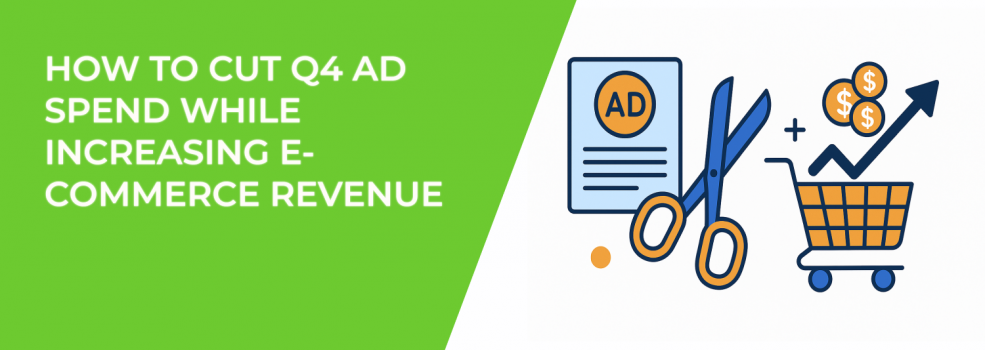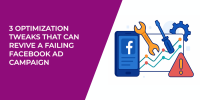Q4 is the highest-stakes season in e-commerce. But as more advertisers pile into Facebook, Instagram, TikTok, and Google Ads, costs go up — while returns often flatten or drop.
The good news? You can still grow revenue without increasing your ad spend. In fact, Q4 is the best time to fix what’s not working, optimize what is, and turn every dollar into more actual profit. Here's how.
1. Refine Your Audiences to Eliminate Budget Waste
Q4 ad costs skyrocket largely because platforms are auction-based. The more advertisers fighting for attention, the higher the cost per 1,000 impressions (CPM). If your targeting is too broad, you’ll end up paying a premium to reach people who have no intention of buying.
Why this matters:
Most advertisers rely on default interest groups or wide lookalikes — but Q4 is not the time to cast a wide net. You want precision. A tighter, cleaner audience often results in a higher click-through rate (CTR) and lower cost per conversion.
If you’re still relying on outdated methods or "boosting" posts to try to reach more people, it’s time for a strategic reset. This guide to Facebook Ad Targeting 101 walks through how to structure audiences that convert — not just click.
How to implement:
-
Create exclusion lists. For example, exclude users who clicked your ad in the last 30 days but didn’t purchase. They’ve already shown hesitation — don't keep spending on them unless you have a special re-engagement campaign.
-
Use value-based lookalikes. Upload your top 10–20% of customers based on lifetime value (LTV) into Meta Ads Manager. Facebook will build lookalikes that mirror your most profitable customers, not just random site visitors.
-
Stack interests with behaviors. Instead of targeting "home décor" fans, narrow it by behavior: target people who like home décor and recently made an online purchase over $50.
Tip: use LeadEnforce to go beyond Meta’s basic interest categories and uncover niche, high-intent audiences that your competitors aren’t reaching.
2. Double Down on High-Performing Channels
Spreading your budget thin across every ad platform might look strategic, but it’s often inefficient — especially when every channel gets more expensive in Q4.
Why this matters:
Not all platforms deliver the same return. Facebook might generate the most traffic, while email converts better. If you’re not reviewing where your money actually converts, you’ll keep spending on top-of-funnel traffic with little payoff.
How to implement:
-
Check your multi-touch attribution reports. If most of your final conversions happen through email or SMS, consider shifting more budget toward lead capture instead of direct purchase campaigns.
-
Pause platforms that drain ROI. If Pinterest or TikTok is eating 25% of your budget but delivering only 5% of revenue, pull back. Run retargeting only or reallocate to where your ROAS is stronger.
-
Focus on Meta’s Advantage+ Shopping Campaigns (ASC). These can be highly efficient in Q4, especially if you have a strong product catalog and existing pixel data.
Need clarity on campaign structure? This article on Meta ad campaign objectives can help you choose the right one for each stage of the funnel.
Let’s say your blended ROAS is 3.2, but Meta is delivering 4.8 and TikTok is at 1.9. You’re better off cutting TikTok to a minimum and focusing on deeper funnel stages on Meta.
3. Avoid Deep Discounts — Use Offers That Protect Margins
Everyone expects Q4 discounts. But that doesn’t mean you need to race to the bottom with a 50% off sale just to compete.
Why this matters:
Over-discounting trains customers to undervalue your brand. Plus, once your profit margins shrink, your ability to spend on ads does too.
How to implement smarter offers:
-
Create product bundles. If you sell skincare, bundle a cleanser, toner, and moisturizer at a 15% discount. The perceived value is high — and your average order value (AOV) rises.
-
Offer free shipping with minimum spend. “Free shipping over $60” pushes shoppers to add one more item to their cart.
-
Use limited edition or seasonal products. Scarcity and exclusivity are powerful Q4 triggers. A candle in a holiday scent or a limited-run hoodie can create urgency without slashing price.
If you want a deeper dive, this article on promoting product bundles covers how to craft the right message and choose the best format for bundle-focused ads.
A coffee brand could offer a “Holiday Mornings Kit” — 2 coffee blends + branded mug + festive packaging — at a small discount. You increase margin, tell a story, and give the shopper a ready-made gift idea.
4. Retarget Strategically Instead of Repetitively
Retargeting can be your most profitable campaign type — or your most wasteful — depending on how you structure it.
Why this matters:
Too many retargeting campaigns rely on one-size-fits-all audiences, like “All website visitors in the last 30 days.” But people at different stages of the funnel need different messages — and not everyone is worth retargeting.
How to implement:
-
Segment by intent. Create separate campaigns for:
-
Add-to-carts (high intent)
-
Product viewers (medium)
-
Homepage visitors (low)
-
-
Shorten your lookback windows. In Q4, decisions happen faster. A 30-day retargeting window might be too long. Try 3-, 7-, and 14-day windows and compare performance.
-
Match your offer to behavior. Someone who viewed a product page 3 times should see a dynamic ad with reviews, benefits, and urgency cues. Someone who added to cart might respond better to a free shipping message or a bonus item.
This article on dynamic retargeting for e-commerce explains how to tailor ad content automatically based on user behavior — ideal for high-volume product catalogs in Q4.
Let’s say a customer viewed a pair of shoes twice, but didn’t purchase. Your retargeting ad could say: “Still thinking about them? Free returns make it risk-free to try.”
That’s smarter than just repeating the same product photo 10 times.
5. Refresh Creative to Beat Fatigue and Reduce Frequency
During Q4, frequency climbs fast. That means users start seeing the same ad over and over — and your CTR drops while your CPM rises.
Why this matters:
Creative fatigue is one of the biggest causes of wasted ad spend. And in a noisy season, boring visuals get scrolled past instantly.
How to implement:
-
Monitor frequency in Ads Manager. Anything over 3.5 should trigger a creative change.
-
Create ad variations in advance. Plan for 4–6 versions of your main offer, using different headlines, formats (carousel, video, image), and visuals.
-
Change more than the image. Update the headline, CTA, and body copy to give your audience a fresh reason to click.
Want help spotting when it’s happening? Here’s how to identify ad fatigue early and fix it fast.
If your original ad is a static image with the headline “20% Off All Outerwear,” try a carousel next time with the headline “Cold-Weather Picks for Every Budget” — and show products by price tier.
6. Optimize the Landing and Checkout Experience
Ads don’t convert — pages do. You could be sending qualified, high-intent traffic to a page that’s killing your revenue potential.
Why this matters:
A slow or confusing site turns buyers into bouncers. Every friction point — loading delays, unclear pricing, clunky checkout — bleeds money, especially when you’re paying a premium for every click.
How to implement:
-
Speed test your site. Use tools like Google PageSpeed or GTmetrix. Aim for under 3 seconds on mobile.
-
Use urgency cues above the fold. Highlight “Ships in 24 hours” or “Low stock” early on the page.
-
Simplify your checkout. Offer guest checkout, show trust badges, and auto-fill fields where possible.
Instead of dumping users on a generic product grid, link your ad to a landing page that matches the offer — like a curated “Gifts Under $50” collection with bestsellers and holiday messaging.
Final Thoughts
Q4 isn’t just about throwing more money into ads — it’s about using what you already have more effectively. When you refine your targeting, adjust your offers, refresh your creative, and focus on channels that actually convert, you protect your budget and unlock more revenue.

